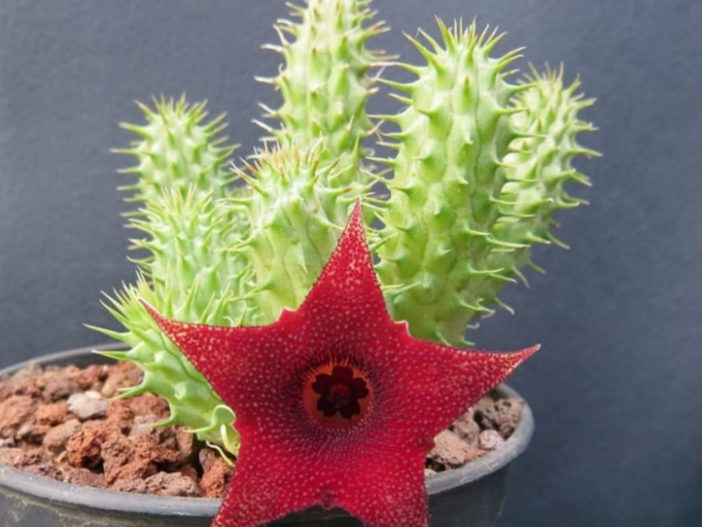Scientific Name
Huernia aspera N.E.Br.
Synonym(s)
Ceropegia aspera
Scientific Classification
Family: Apocynaceae
Subfamily: Asclepiadoideae
Tribe: Stapeliae
Genus: Huernia
Description
Huernia aspera is a small succulent with mid-green to purplish, obtusely five- to six-angled stems with small, rigid, tooth-like, horizontal rudimentary leaves. The stems are trailing to ascending and can grow up to 9 inches (22.5 cm) long and 0.5 inches (1.2 cm) thick.
Clusters of 3 to 5 (sometimes more) flowers appear near the base of the young stems in the fall. The flowers are bell-shaped and measure up to 0.5 inches (1.2 cm) long and 1 inch (2.5 cm) in diameter. The corolla is dull purple and rough with numerous papillae on the outside and uniform blackish-purple and densely covered with pointed papillae on the inside. The outer corona lobes are intense blackish-crimson, while the inner ones are yellowish.
Origin
Huernia aspera is native to Kenya, Tanzania, and Malawi.

Hardiness
USDA hardiness zone 10b to 11b: from 35 °F (+1.7 °C) to 50 °F (+10 °C).
How to Grow and Care
Huernias require a potting mix with excellent drainage. A succulent plant mix of 50 percent pumice or perlite, 25 percent peat or organic mulch, and 25 percent sand helps prevent rotting and overwatering. Roots experience dieback in cool-season dormancy, so plants grow best in shallow containers that allow the soil to dry out quickly. Using clay pots further helps the soil from staying too wet. An underlayment of coarse gravel below the soil mix also improves drainage. In climates with damp, cool summers, a layer of gravel between the plant and the soil mix also helps prevent the stems from staying too moist.
Outdoor plantings do well in raised beds. Huernias prefer bright light or partial shade. In nature, they grow underneath shrubs or other plants. Too much sun causes stems to develop protective reddish or purple pigmentation and can scald the stems. Too little light leads to weak, thin growth with decreased flower production. These plants grow best between 50 and 80 °F (10 and 27 °C). Protect them from freezing weather.
See more at How to Grow and Care for Huernia.
Links
- Back to genus Huernia
- Succupedia: Browse succulents by Scientific Name, Common Name, Genus, Family, USDA Hardiness Zone, Origin, or cacti by Genus
Photo Gallery
Click on a photo to see a larger version.



